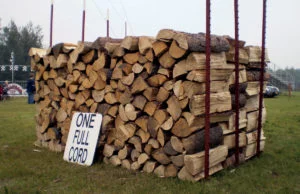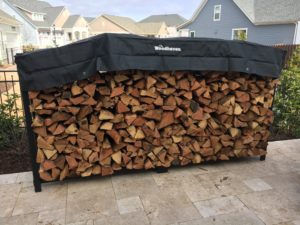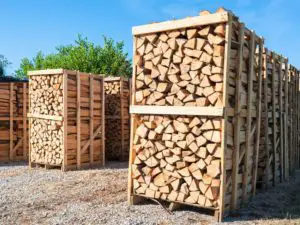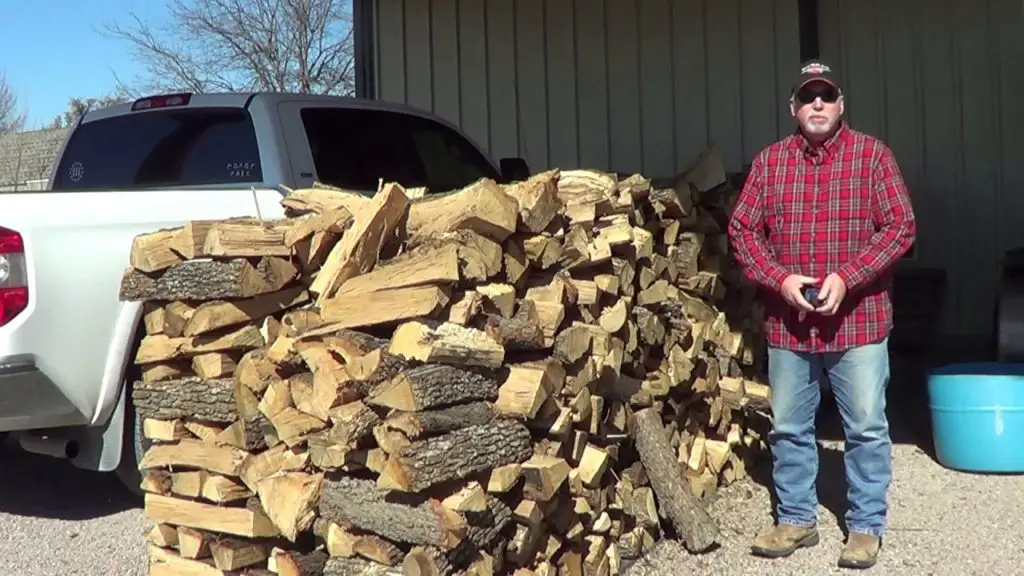Do you have a home heating and cooking system that needs firewood? If not, you need to know how to get your hands on them at a reasonable price because of their duality and usefulness.
You’ve probably never dealt with wood measurements, and you get so confused with few words related to wood measurement. The most usual of these is a rick.
What is a rick of wood or face cord of firewood? How long will it last? And so many others are the questions popping from your mind. In this article, I will explain all of that and give you the guideline on how to purchase a rick of wood.
When buying firewood, it’s even easier to pay more than you should because you don’t go to a store with pre-advertised prices.
Don’t pay more for a cord of wood than it’s worth! How to stack a rick of wood and how much it can cost to procure them are the questions answered in this article.
WHAT IS RICK
According to the Oxford dictionary, Rick is a stack, stook, pile straw, hay, etc., specially protected with thatching. The term rick comes from an old English word, meaning pile or stack. It, however, refers to farm-related piles such as hay, wood, corn and a variety of other things.
RICK OF WOOD

A rick of wood also referred to as face cord of wood, is a pile or stook of firewood about eight feet long, four feet high and four feet wide or about 128 cubic feet. The width of the rick sometimes depends on where you buy it from.
A face cord describes the width of a rick of firewood, which measures 12-,16- or 24-inch; this means that each of the lumbers of firewood within that stook will be one of the previous lengths. Generally, a full cord measures 48 inches wide, and the most common size of firewood timber is about 16 inches.
WEIGHT OF RICK OF WOOD
Summarily, the rick of wood varies, which is based on the sizes you pick. It also depends on the type of firewood you are picking because the denser types of wood are red oaks and white oaks.
So, they tend to weigh more, which can be almost two and a half tons (or 5,500 lbs) if a single cord.
The less-dense types of firewood will be dapper. Moreso, a full cord is about a ton and a quarter (or 2,500 lbs) per cord. However, with the width numbers, it can be ranged from 625 lbs on the lower end to about 3,000 lbs on the higher end.
SHELDON CORD, STOVE CORD
A Sheldon cord is another popular term. It’s most often described as “more than a full cord.” It varies depending on your region of the world. A stove cord is common, but it’s usually meant to describe the length of the logs.
Pieces of firewood cut to 12-inches in length will fall into this category more often than not. Someone might say a “stove cord” is 1/4th of a full cord because it is stacked 8 feet long by 4 feet tall, and the logs are 12-inches in length. Be sure to clarify before buying.
These are just a few examples of what you might hear when you go to purchase wood. Others include running truckload, country cord, and more.
What matters is that you know the measurements of a full cord. Most other terms are based on the length of the firewood or percentages of wood compared to a full cord.
REGIONAL MEASUREMENTS
The measurements for a full cord vary depending on where in the world you live. The vast majority of people reading this will be from English-speaking countries like the United States, Canada, and the United Kingdom.
Whether you live in one of the countries or not, I’m going to do my best to give you the information you’re looking for.
Since I live in the US, I can’t say with absolute certainty that the measurements below are 100% accurate because each region has their measurements. Now see all the regional measurements below:
- United States & Canada: 128 cubic feet or 8-ft x 4-ft x 4-ft
- France: 2 – 3 steres (corde) vastly different depending on location
- Germany: 2 variants of 1.4 or 1.0 cubic meters – 14 ft wide x 3 feet deep x 3 feet high
It’s a shortlist for now, but this is all I could find. I expect to do more research in the future to add to this list. If you’re from another region of the world and you happen to know the measurements, please educate us in the comment section below.
SEASONED WOOD
All wood contains water, and that includes firewood. Freshly cut wood can be up to 45% water, while well-seasoned firewood generally has 20-25% moisture content.
Well-seasoned firewood is easier to start, produces more heat, and burns cleaner. Just remember that most of the water must be gone before the wood will burn well.
If your wood is cut six months to a year in advance and properly stored, the sun and wind will do this job for you for free, and who doesn’t like free?
If you burn green wood, the heat produced by combustion has to dry the wood first before burning. This method uses up a large percentage of the available energy in the process and is a wasted resource.
The result is less heat delivered to your home and gallons of acidic water in the form of creosote deposited in your chimney!
Wood is composed of bundles of microscopic tubes used to transport water from the roots of the tree to the leaves. These tubes will stay full of water for years, even after a tree is dead.
To ensure a well-dried wood, it’s so important to have your firewood cut to length, 12 to 18 inches depending on the size of your fireplace, for six months or more before you burn it to give the water a chance to evaporate since the tube ends are finally open.
The water only has to travel a foot or two to drain. Splitting the wood helps, too, by exposing more surface area of the wood to the sun and wind; however, cutting the wood into shorter lengths is the most important thing.
There are a few things you can look for to see if the wood you intend to purchase is seasoned or not. Well-seasoned firewood generally has darkened ends with cracks or splits visible. It is also relatively lightweight and makes a clear “clunk” when two pieces are beaten together.
On the other hand, Greenwood is very heavy, the ends look fresher and will sometimes have a sap-like substance draining, and it tends to make a dull “thud” when struck together.
However, these clues can sometimes fool you, so the best thing to do to know you have well-seasoned wood when you need it is to buy your wood the spring before you intend to burn it and store it properly.
HOW MANY PIECES MAKES UP CORD OF WOOD
Generally, there are about 550 to 650 pieces of divided wood in a cord of wood, so, depending on how it’s been cut and most importantly, how it,s stacked tightly. Hence, it would help if you looked at about 275 to 325 pieces of brushwood in a rick.

COST OF RICK OF WOOD
That depends on whether you use your chainsaw to cut the wood and haul it yourself. Or whether you purchase a cord from someone else who did the work.
Ultimately, cutting your wood will save you big bucks. However, don’t forget to include the price of your saw when you calculate startup costs.
We’ll show you exactly how to calculate how much a cord of wood should cost.
How many pieces of wood in a cord, you ask? Typically cords are measured by cubic feet, not pieces. But typically, a full cord could contain between 600 and 800 pieces.
Similar to anything otherwise about a rick of wood, it vigorously depends on your place and merchant. But for a rick or face cord of oak, you can equally expect to pay between $150 and $250.
The cost of a rick of wood can and may vary depending on the type of wood you pick, such as red oak and maple, if certainly it has been dried.
USES OF FIREWOOD
Firewood, also known as fuelwood, serves as fuel for heating, cooking, and power production.
Firewood lowers your utility costs for cooking, which is the most effective fuel for domestic heating. It is six times more economical than electric heat, five times more economical than gas heat, and four times more economical than oil.
GUIDELINE ON HOW TO PURCHASE A RICK OF WOOD
How do you purchase a rick of wood? Because you don’t have an idea of how much it will cost you. You need to purchase a rick.
If the lumber is cut between 16 inches long and stacked 4 feet high by 8 feet long, you have 1/3 of a cord. The rick you will be purchasing will be a third of a cord.
So, the easiest way to find out the metric of a rick of wood is to measure the lengths of the timber. You can as well count the timbers if you have enough time. It’s a good way to know if the timbers you are going home will be enough.
What Tree Species are Best for Firewood?
Any wood will burn, but different types of trees have different wood characteristics related to fuel use. The potential heat content, burning characteristics, and overall usefulness as firewood vary widely across tree species.
Of these characteristics, the heat value or the amount of heat generated by burning the wood is the most important when selecting firewood. The species include hickory, black locust, oak, and honeylocust, with an excellent overall rating.
Species rating very good includes American Persimmon and white ash. Maples have a good rating, with pine and Eastern Red cedar rating fair, and willow and cottonwood trees are rated poor for firewood.
HOW MUCH HEAT CAN THE WOOD RELEASE?
Heat value is measured in British Thermal Units or BTUs. The BTU is a standard measure of heat such that one BTU is equal to the amount of heat required to raise the temperature of one pound of water one degree Fahrenheit.
The heat value of wood depends on its density and moisture content or water in the wood. The drier and more dense or heavier the wood, the more heat is released when properly burned. Hardwood trees tend to be denser than softwood trees.
HOW TO STACK A RICK OF WOOD

- Find a flat area outside your home. If it’s not flat, the pile will topple over. It’s advisable to place a big piece of plywood or a pallet down first; This will ensure the place is flat and straight and serve as a barrier between the moist ground and the wood.
- Lay down one row of logs 8-feet (2.4-meters) long and 4-feet (1.2-meters) wide. Try to choose flat bottomed pieces for the bottom row so that the pile won’t topple.
- Place some logs at right angles to the main stack to hold the ends and make the stack strong and stable.
- Place the logs one on top of another between the end rows. Make sure they’re placed neatly and fit one next to the other. Avoid leaving too much space between the logs.
- Continue making rows until the stack is 4 feet (1.2 meters) high.
- Lean branches against the pile to keep it from slipping over
- Fix a good waterproof cover over the pile to protect it from rain.
SPLITTING AND STORING FIREWOOD
The more surface area without bark exposed to air, the more rapidly the firewood will dry after splitting. Don’t neglect small round pieces of wood that need to be split for drying. Tools required for splitting by hand include axes, mauls and wedges.
Motorized or hydraulic splitters are also common and take some of the back-breaking labour out of wood splitting. Whenever possible, firewood should not be stored in contact with the ground as moisture can move from the ground to the firewood.
All firewood, regardless of how it is stored, will decay over time. It is best to burn older firewood first. Most species of firewood will decay and become infested with wood-boring and eating insects after just two seasons. Try not to carry over large quantities of firewood from season to season.
GAS STATION WOOD
Gas station and store-bought firewood are even worse. This firewood is typically sold by the cubic foot or by ¾ of a cubic foot. The cost for a full cord of wood from a dealer comes out to about $2.34 per cubic foot for a $300 cord.
The store-bought and gas station firewood is usually anywhere from $6-$10 per cubic foot – an even worse proposition than Bob’s standard of measurement above.
KNOW-HOW
Here’s a tip for finding out a seller has a full cord in their rick. Pace off the length of the cord (if you know how long your stride is), or take a tape measure with you to measure exactly what the dimensions are and calculate the cubic feet before you make your purchase.
If the wood has been cut and split already, you might expect to pay more than you would pay for neatly stacked logs in a rick; this is because of increased labor.
If you decide it’s too much money and you would like to save by cutting your wood, we have the perfect guide to get you started – happy chainsawing.
CONCLUSION
It’s a vital task to ascertain the size of a rick of wood because there is no accurate measurement for a rick. Rick is a term to delineate a stack or pile of wood.

